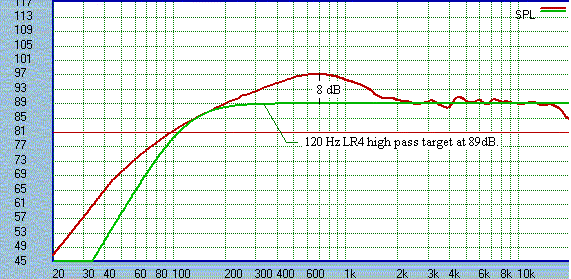NaO Design.....
___________________________
Hybrid Design Philosophy applied to the NaO II RS:
PLEASE NOTE: These pages are now for historical purposes. Music and Design is no longer offering these products for sale.
Previous customers may contact Music and Design for followup inquiries.

The concept of hybrid design is discussed in greater detail on another page. Here we briefly examine
the result of applying the hybrid design philosophy to the NaO II RS midraneg/tweeter panel. Figure 1
shows the measured response of the NaO II RS panel with the passive midrange/tweeter crossover in
place in red. This is the panel response prior to application of the active equalization. Shown in green is
the nominal target response of the panel, a 120 Hz, Linkwitz Riley 4th order high pass response with a
target level of 89dB/2.83V/M. As can be seen, the midrange response is everywhere equal to or above
the target level. In the critical midrange the sensitivity increases by as much 8 dB to 97dB/2.83V/M.
the result of applying the hybrid design philosophy to the NaO II RS midraneg/tweeter panel. Figure 1
shows the measured response of the NaO II RS panel with the passive midrange/tweeter crossover in
place in red. This is the panel response prior to application of the active equalization. Shown in green is
the nominal target response of the panel, a 120 Hz, Linkwitz Riley 4th order high pass response with a
target level of 89dB/2.83V/M. As can be seen, the midrange response is everywhere equal to or above
the target level. In the critical midrange the sensitivity increases by as much 8 dB to 97dB/2.83V/M.

This frequency dependent sensitivity could be dealt with using a passive crossover in
which case the with 2.83 volts applied across the terminals of the crossover the voltage
applied across the driver would be attenuated, as represented by the gray areas in
Figure 2, to bring the acoustic output of the driver to the target. Thus at 700 Hz the
amplifier would be delivering a signal at the 0dB level while the signal reaching the driver
would be at -8dB with 8dB ot amplifier head room being wasted. Additionally, the
amplifier would be delivering the same 0 dB signal across the crossover below the cut off
point of the high pass filter resulting in further amplifier head room being wasted.
which case the with 2.83 volts applied across the terminals of the crossover the voltage
applied across the driver would be attenuated, as represented by the gray areas in
Figure 2, to bring the acoustic output of the driver to the target. Thus at 700 Hz the
amplifier would be delivering a signal at the 0dB level while the signal reaching the driver
would be at -8dB with 8dB ot amplifier head room being wasted. Additionally, the
amplifier would be delivering the same 0 dB signal across the crossover below the cut off
point of the high pass filter resulting in further amplifier head room being wasted.

By contrast, by applying active equalization as shown in Figure 3, the signal applied to the
amplifier is attenuated and the amplifier delivers only the voltage required to based on the
true, frequency dependent sensitivity of the NaO II RS panel. This not only results in
holding as much as 8dB of the amplifier's capability in reserves, but also removes the
need for the panel amplifier to be subjected to the low frequency content of the source
material.
amplifier is attenuated and the amplifier delivers only the voltage required to based on the
true, frequency dependent sensitivity of the NaO II RS panel. This not only results in
holding as much as 8dB of the amplifier's capability in reserves, but also removes the
need for the panel amplifier to be subjected to the low frequency content of the source
material.
Figure 1. Response of NaO II RS midrange/tweeter panel prior to
application of active equalization, red, and target response for panel,
green.
application of active equalization, red, and target response for panel,
green.
Figure 2. Wasted amplifier head room, grey area, if panels were equalized using a
passive network/high pass filter.
passive network/high pass filter.
Figure 3. The grey area shows the amplifier head room retained in reserve through the
use of an active high pass crossover and equalization.
use of an active high pass crossover and equalization.
